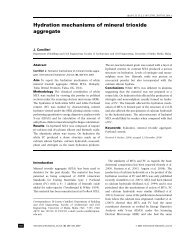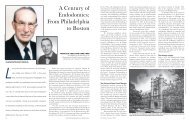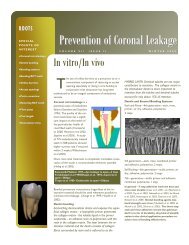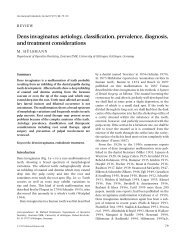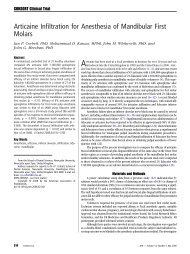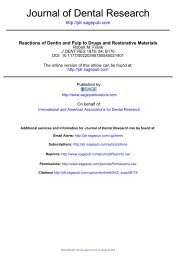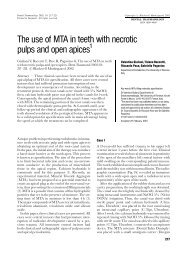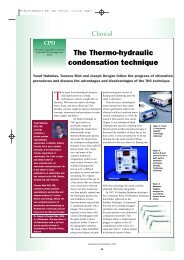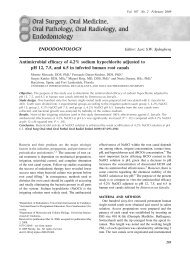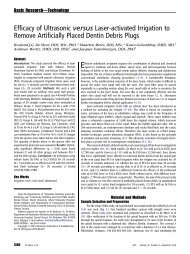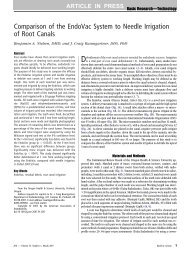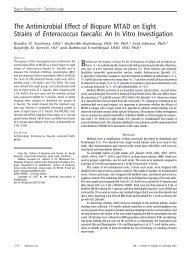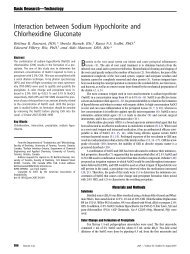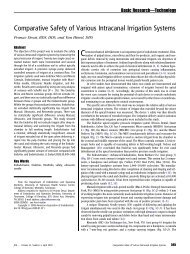Irrigation in Endodontics - The Endoexperience
Irrigation in Endodontics - The Endoexperience
Irrigation in Endodontics - The Endoexperience
Create successful ePaper yourself
Turn your PDF publications into a flip-book with our unique Google optimized e-Paper software.
Box 1<br />
Desired functions of irrigat<strong>in</strong>g solutions<br />
Wash<strong>in</strong>g action (helps remove debris)<br />
Reduce <strong>in</strong>strument friction dur<strong>in</strong>g preparation (lubricant)<br />
Facilitate dent<strong>in</strong> removal (lubricant)<br />
Dissolve <strong>in</strong>organic tissue (dent<strong>in</strong>)<br />
Penetrate to canal periphery<br />
Dissolve organic matter (dent<strong>in</strong> collagen, pulp tissue, biofilm)<br />
Kill bacteria and yeasts (also <strong>in</strong> biofilm)<br />
Do not irritate or damage vital periapical tissue, no caustic or cytotoxic effects<br />
Do not weaken tooth structure<br />
<strong>Irrigation</strong> <strong>in</strong> <strong>Endodontics</strong> 293<br />
hypochlorous acid (HOCl). At acidic and neutral pH, chlor<strong>in</strong>e exists predom<strong>in</strong>antly<br />
as HOCl, whereas at high pH of 9 and above, OCl predom<strong>in</strong>ates. 3 Hypochlorous<br />
acid is responsible for the antibacterial activity; the OCl ion is less effective<br />
than the undissolved HOCl. Hypochloric acid disrupts several vital functions of the<br />
microbial cell, result<strong>in</strong>g <strong>in</strong> cell death. 4,5<br />
NaOCl is commonly used <strong>in</strong> concentrations between 0.5% and 6%. It is a potent<br />
antimicrobial agent, kill<strong>in</strong>g most bacteria <strong>in</strong>stantly on direct contact. It also effectively<br />
dissolves pulpal remnants and collagen, the ma<strong>in</strong> organic components of dent<strong>in</strong>.<br />
Hypochlorite is the only root-canal irrigant of those <strong>in</strong> general use that dissolves<br />
necrotic and vital organic tissue. It is difficult to imag<strong>in</strong>e successful irrigation of the<br />
root canal without hypochlorite. Although hypochlorite alone does not remove the<br />
smear layer, it affects the organic part of the smear layer, mak<strong>in</strong>g its complete removal<br />
possible by subsequent irrigation with EDTA or citric acid (CA). It is used as an unbuffered<br />
solution at pH 11 <strong>in</strong> the various concentrations mentioned earlier, or buffered<br />
with bicarbonate buffer (pH 9.0), usually as a 0.5% (Dak<strong>in</strong> solution) or 1% solution. 3<br />
However, buffer<strong>in</strong>g does not seem to have any major effect on the properties of<br />
NaOCl, contrary to earlier belief. 6<br />
<strong>The</strong>re is considerable variation <strong>in</strong> the literature regard<strong>in</strong>g the antibacterial effect of<br />
NaOCl. In some articles hypochlorite is reported to kill the target microorganisms <strong>in</strong><br />
seconds, even at low concentrations, although other reports have published considerably<br />
longer times for the kill<strong>in</strong>g of the same species. 7–10 Such differences are a result<br />
of confound<strong>in</strong>g factors <strong>in</strong> some of the studies. <strong>The</strong> presence of organic matter dur<strong>in</strong>g<br />
the kill<strong>in</strong>g experiments has a great effect on the antibacterial activity of NaOCl.<br />
Haapasalo and colleagues 11 showed that the presence of dent<strong>in</strong> caused marked<br />
delays <strong>in</strong> the kill<strong>in</strong>g of Enterococcus faecalis by 1% NaOCl. Many of the earlier studies<br />
were performed <strong>in</strong> the presence of an unknown amount of organic matter (eg, nutrient<br />
broth) or without controll<strong>in</strong>g the pH of the culture, both of which affect the result. When<br />
the confound<strong>in</strong>g factors are elim<strong>in</strong>ated, it has been shown that NaOCl kills the target<br />
microorganisms rapidly even at low concentrations of less than 0.1%. 9,12 However, <strong>in</strong><br />
vivo the presence of organic matter (<strong>in</strong>flammatory exudate, tissue remnants, microbial<br />
biomass) consumes NaOCl and weakens its effect. <strong>The</strong>refore, cont<strong>in</strong>uous irrigation<br />
and time are important factors for the effectiveness of hypochlorite.<br />
Byström and Sundqvist 13,14 studied the irrigation of root canals that were necrotic<br />
and conta<strong>in</strong>ed a mixture of anaerobic bacteria. <strong>The</strong>se <strong>in</strong>vestigators showed that us<strong>in</strong>g



